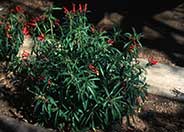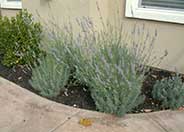
Common name:Mexican Bush Sage
Botanical name:Salvia leucantha
The Mexican Sage is a bushy shrub that grows 3'-4' tall and wide. It has hairy white stems, gray green leaves and velvet-like purple flower spikes that bloom summer through fall. This shrub tolerates sun, light shade, little water, and is hardy to 15 degrees F. The Mexican Sage is drought tolerant and attracts hummingbirds. -Cornflower Farms

Common name:Red Mexican Lobelia
Botanical name:Lobelia laxiflora
This Lobelia is a very showy, shrub-like perennial, growing to 2'-4' tall. It spreads by underground rhizomes. It has bright, tubular, orange-red summer flowers with yellow orange throats. It can tolerate low water conditions. Hummingbirds love this Lobelia. It thrives in wet soil but does not require it. This is the most tolerant of Lobelias for full sun sites.

Common name:Hedge Lavender
Botanical name:Lavandula X intermedia
With tall, 24-30" stems, 'Provence' has true, lavender colored flowers that are fragrant and excellent for cutting. It flowers in early June and has large, gray/green leaves.

Common name:Carmel Creeper
Botanical name:Ceanothus griseus horizontalis
Carmel Creeper is one of the most popular forms of spreading shrubs. Its glossy oval leaves of 2" are bright green. The tiny, light blue flowers are abundant and form 1" clusters. This shrub benefits from pruning. It does best in well-drained soil with little to no summer water.

Common name:Coast Sunflower, Coast Encelia
Botanical name:Encelia californica
Encelia californica is a fast growing woody subshrub with bright green foliage and yellow daisy-type flowers. It can be used effectively in the natural landscape with regular pruning to maintain form. It is more commonly used in native restoration work. In inland situations, it requires more regular water. It grows to 3'-5' tall and 3'-5' wide.

Common name:Dwarf Periwinkle, Dwarf Vinca
Botanical name:Vinca minor
This groundcover will grow less than 1' tall and has small, glossy, dark green leaves with blue, purple, lavender, or white flowers that bloom in the spring.
Pest Management
Are pests bugging you? If pests are taking over there might be a good reason! Instead of grabbing that bottle of spray, consider using techniques that can solve your pest problems without toxic pesticides.
Click in the green box for more information
| Designer: Nan Simonsen Nanscapes | Green Sea |
Photographer: GardenSoft |
Soils and Compost:
Maintain a two to four inch layer of mulch on the soil surface to reduce weeds, infiltrate rain water, and reduce compaction.
Water Saving Tip:
Integrated Pest Management:
Drip and other smart irrigation delivers water directly to roots, allowing no excess water for weeds.

